Tuesday, 30 June 2020
The race riots of 1919 in America and Britain
Lynching, stoning and burning: The 1919 'Red Summer' race riots that America and Britain want you to forget but which echo today
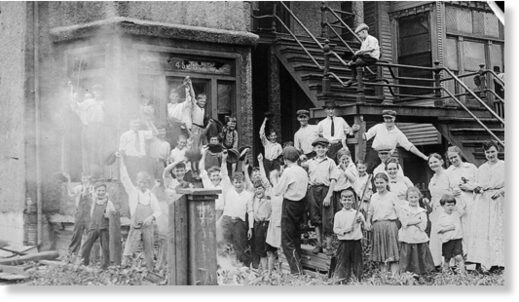
29 June, 2020
In 1919, hundreds of people were murdered in race riots across the US and UK. Men, women and children were butchered. So why is it a footnote in history? Because the media and governments don't want you to know how they reacted.
Warning: The following article contains images that may be disturbing to some readers
Remember when we thought that 2020 was going to be the Year of Coronavirus? Then along came the murder of George Floyd and the subsequent protests, violent unrest and clashes between police, the far right and anti-fascists. Covid-19 is going to have to share top billing.
Remember, too, how everyone compared the virus to the Spanish flu pandemic of 1918-19? And yet few people compared the protests and violence to another event from that time: "Red Summer". That's because these bloody and shameful few months in 1919 aren't the kind of history that countries want to teach their kids.
Red Summer saw hundreds of people killed in a series of race riots across the US. Most deaths were white-on-black - including people being lynched, stoned to death and burned at the stake - but it was also the first time the black population had resisted the violence, both peacefully and with force. And, while the words and images of such medieval savagery chill the blood, and the levels of cruelty astound a 21st-century sensibility, there are parallels with 2020.
So, what fuelled it and why has it been brushed under the carpet of history?
The US at the time was a deeply racially divided country led by President Woodrow Wilson - a supporter of the Ku Klux Klan who was against black suffrage and actually resegregated elements of American society. White-led race riots and lynchings were commonplace - from 1889 to 1918, more than 3,000 were lynched, 2,472 of whom were black men and 50 black women. Black people, despite emancipation 57 years earlier, had far fewer rights than white people. But what lit the touchpaper for the bloodshed of 1919, and what made it so significant, was the return of soldiers from World War One.
Armed, Angry And Ready to Fight
These soldiers, both white and black, were demobilised at a time of already-rising racial tension and economic difficulty. They were trained to fight and, in many cases, were suffering from "shell shock" (nowadays known as PTSD). Violence flared easily.
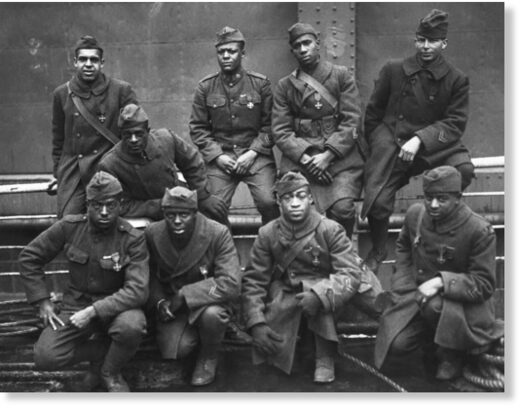 White servicemen jumped on fabricated rumours of white women being assaulted by "Negro fiends" - rumours sensationalised by the press - and went on random sprees of assault and murder. The Washington Post, that famously "liberal" rag, even ran a front-page story organising white servicemen to gather at a certain location so they could attack black people in the city en masse.
White servicemen jumped on fabricated rumours of white women being assaulted by "Negro fiends" - rumours sensationalised by the press - and went on random sprees of assault and murder. The Washington Post, that famously "liberal" rag, even ran a front-page story organising white servicemen to gather at a certain location so they could attack black people in the city en masse.
The white servicemen had also come home to cities with few available jobs and homes, an economy ravaged by war and a pandemic, and an influx of black workers from the South, due to war-related labour shortages.
By 1919, in the first wave of the Great Migration, an estimated 500,000 African Americans had moved to the industrial cities of the Northeast and Midwest. Between 1910 and 1920, the black population in Chicago grew by 148 per cent and in Philadelphia by 500 per cent. Alongside the economic effects, white people blamed these black migrants for spreading Spanish flu - a foreshadowing, perhaps, of those just waiting to blame a spike in Covid-19 infections on Black Lives Matter rallies.
Some black migrants prospered, creating a new black middle class. This both enraged and frightened people used to a "white privilege" that was off the charts compared to today.
Black soldiers returned to a different set of ire-inducing issues. They came home from risking their lives for their country to discover that their country and its president didn't see them as complete human beings. At least 13 black veterans were lynched after the war. They weren't war heroes; they were second-class citizens. But they were also motivated and emboldened.
A Bloody Rampage
"Red Summer" - a phrase coined by the National Association for the Advancement of Colored People's (NAACP) field secretary, James Weldon Johnson, referring to the bloodshed - was a series of events. The most serious of these began in April and ended in November. In that time, across dozens of American cities, white mobs, including women and children rampaged, destroying black properties and churches, and murdering black people.
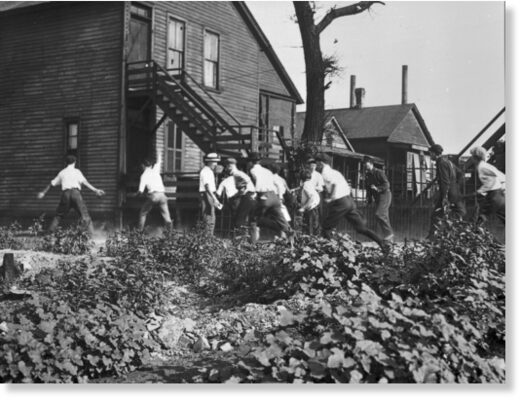 The Ku Klux Klan had a resurgence after decades of slumber, committing 64 lynchings in 1918 and 83 in 1919. In one of the deadliest events, more than 200 black Americans of all sexes and ages were massacred in Elaine, Arkansas, after black sharecroppers campaigned for better working conditions.
The Ku Klux Klan had a resurgence after decades of slumber, committing 64 lynchings in 1918 and 83 in 1919. In one of the deadliest events, more than 200 black Americans of all sexes and ages were massacred in Elaine, Arkansas, after black sharecroppers campaigned for better working conditions.
Many of the attacks were focused on those black veterans, who numbered around 380,000 and were seen as a threat to white supremacy and power. They had fought for their country, so why shouldn't they be treated the same as everyone else? They had returned battle-hardened and ready to stand up for equal rights and for themselves.
This meant that, in some cities, for the first time, black people fought back against the brutality, notably in Chicago and Washington, DC, where riots saw both black and white people killed (albeit still mostly black). In Chicago, 23 black people and 15 white people died after a black teenager, Eugene Williams, drifted on his raft into a whites-only section of Lake Michigan. He drowned when a white man, George Stauber, threw rocks at him, knocking him unconscious.
Despite several witnesses, a white police officer refused to arrest Stauber. Black people protested and, reacting to that, white mobs swarmed through the city, shooting at and torching buildings as they went. Still, the police did nothing, so black veterans organised to defend their neighbourhoods. The riots lasted a week and, alongside the 38 deaths, 537 people were injured and an estimated 1,000 to 2,000 lost their homes.
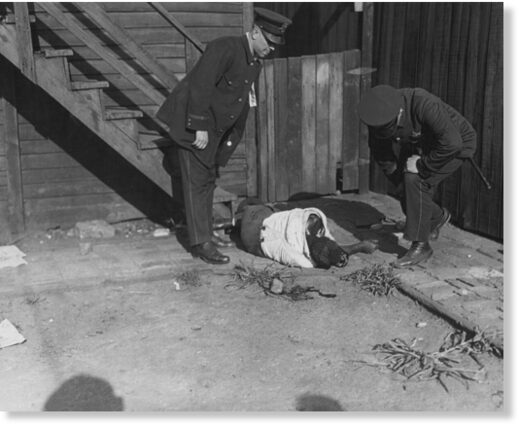 Similar riots took place in British cities, too - mainly in ports such as London, Glasgow, Liverpool, Cardiff and Hull. Five people were killed - all non-white - as soldiers returned from an even longer war than the Americans endured, to find similar hardship and similarly easy-to-blame minorities, including South Asian, African, Afro-Caribbean, Chinese and Arab sailors.
Similar riots took place in British cities, too - mainly in ports such as London, Glasgow, Liverpool, Cardiff and Hull. Five people were killed - all non-white - as soldiers returned from an even longer war than the Americans endured, to find similar hardship and similarly easy-to-blame minorities, including South Asian, African, Afro-Caribbean, Chinese and Arab sailors.
Ignored & Forgotten Because of Shame?
And yet few people know about any of this. There is relatively little reference to it in the mainstream or any other media. Nor in any school curriculum. This is probably because the greatest shame was how the press and authorities reacted.
In the UK, the British government, still with a huge multi-ethnic empire, intensified its repatriation scheme. It removed colonial citizens to avoid a "black backlash," offering a resettlement allowance. Between 1919 and 1921, an estimated 3,000 black and Arab seamen and their families were deported under the scheme.
In the US, black resistance was politicised. It was leapt on by the federal government and the press as being Marxist and pro-Soviet. This being just two years after the Russian Revolution, black-rights movements were labelled "Bolshevik." Sound familiar?
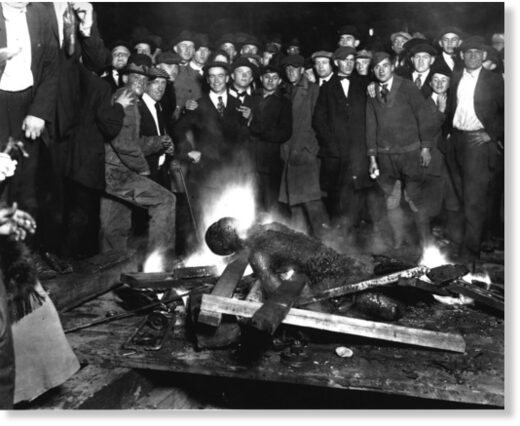 Just about every mainstream newspaper, including other supposedly "liberal" titles, such as the New York Times and Wall Street Journal, spun the line of black "Bolsheviks." The Times ran the headline "Reds Try to Stir Negroes to Revolt."
Just about every mainstream newspaper, including other supposedly "liberal" titles, such as the New York Times and Wall Street Journal, spun the line of black "Bolsheviks." The Times ran the headline "Reds Try to Stir Negroes to Revolt."
This was in part due to federal briefings to the press. The state was determined to ignore racial inequality and heap the blame on socialists. The attorney general, A. Mitchell Palmer, reported to Congress on the anarchist and Bolshevik threat, and accused black community leaders of an "ill-governed reaction toward race rioting."
The riots also coincided with the beginning of J. Edgar Hoover's notorious career. He blamed the Washington riots on "numerous assaults committed by Negroes upon white women," despite an absence of evidence, and the Elaine massacre on "agitation in a Negro lodge." He also initiated an investigation of "Negro activities."
While there were most certainly leftist elements at play, the resistance was without question a defensive reaction to years of unpunished violence by white individuals and mobs. There was no grey area in all this, no "very fine people" on both sides. Yet only one major report, by Dr George Haynes, a black civil servant and academic, in October 1919, recognised this, noting lynching as a national problem and connecting it to the riots.
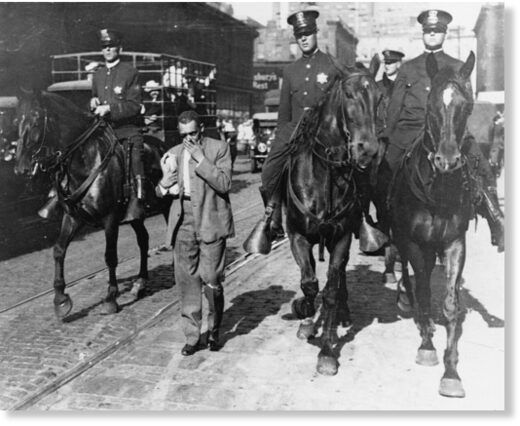 He wrote: "Persistence of unpunished lynchings of Negroes fosters lawlessness among white men imbued with the mob spirit and creates a spirit of bitterness among Negroes. In such a state of public mind, a trivial incident can precipitate a riot... Unchecked mob violence creates hatred and intolerance, making impossible free and dispassionate discussion, not only of race problems, but questions on which races and sections differ."
He wrote: "Persistence of unpunished lynchings of Negroes fosters lawlessness among white men imbued with the mob spirit and creates a spirit of bitterness among Negroes. In such a state of public mind, a trivial incident can precipitate a riot... Unchecked mob violence creates hatred and intolerance, making impossible free and dispassionate discussion, not only of race problems, but questions on which races and sections differ."
'American Apartheid'
President Wilson had condemned the violence but refused to take any significant action to stop it. Not only that, but after months in which black people were butchered in the most horrific and sadistic manners imaginable - strung up, stoned and burned alive - the authorities did nothing to improve their lot. No legal protections, no additional rights. Indeed, as Geoff Ward, a professor of African and African American studies at Washington University in St Louis, recently told NBC, it made things worse.
"That reign of racial terror, where again the exculpatory work of the white press, police, grand juries and others ensured that perpetrators were protected rather than punished, undoubtedly prolonged the period of American apartheid," he said.
The violence continued. More riots occurred, some even bloodier than those of 1919. Nothing changed for black people, but something did change in black people - something that carried through to the civil rights movement of the 1950s and 1960s, and into today. They were now prepared to fight back.
Warning: The following article contains images that may be disturbing to some readers
Remember when we thought that 2020 was going to be the Year of Coronavirus? Then along came the murder of George Floyd and the subsequent protests, violent unrest and clashes between police, the far right and anti-fascists. Covid-19 is going to have to share top billing.
Remember, too, how everyone compared the virus to the Spanish flu pandemic of 1918-19? And yet few people compared the protests and violence to another event from that time: "Red Summer". That's because these bloody and shameful few months in 1919 aren't the kind of history that countries want to teach their kids.
Red Summer saw hundreds of people killed in a series of race riots across the US. Most deaths were white-on-black - including people being lynched, stoned to death and burned at the stake - but it was also the first time the black population had resisted the violence, both peacefully and with force. And, while the words and images of such medieval savagery chill the blood, and the levels of cruelty astound a 21st-century sensibility, there are parallels with 2020.
So, what fuelled it and why has it been brushed under the carpet of history?
The US at the time was a deeply racially divided country led by President Woodrow Wilson - a supporter of the Ku Klux Klan who was against black suffrage and actually resegregated elements of American society. White-led race riots and lynchings were commonplace - from 1889 to 1918, more than 3,000 were lynched, 2,472 of whom were black men and 50 black women. Black people, despite emancipation 57 years earlier, had far fewer rights than white people. But what lit the touchpaper for the bloodshed of 1919, and what made it so significant, was the return of soldiers from World War One.
Armed, Angry And Ready to Fight
These soldiers, both white and black, were demobilised at a time of already-rising racial tension and economic difficulty. They were trained to fight and, in many cases, were suffering from "shell shock" (nowadays known as PTSD). Violence flared easily.

© Getty Images/Corbis
Nine African American soldiers who won the Croix de Guerre, 369th (15th NY) return home on the Stockholm, February 12,1919.
Nine African American soldiers who won the Croix de Guerre, 369th (15th NY) return home on the Stockholm, February 12,1919.
The white servicemen had also come home to cities with few available jobs and homes, an economy ravaged by war and a pandemic, and an influx of black workers from the South, due to war-related labour shortages.
By 1919, in the first wave of the Great Migration, an estimated 500,000 African Americans had moved to the industrial cities of the Northeast and Midwest. Between 1910 and 1920, the black population in Chicago grew by 148 per cent and in Philadelphia by 500 per cent. Alongside the economic effects, white people blamed these black migrants for spreading Spanish flu - a foreshadowing, perhaps, of those just waiting to blame a spike in Covid-19 infections on Black Lives Matter rallies.
Some black migrants prospered, creating a new black middle class. This both enraged and frightened people used to a "white privilege" that was off the charts compared to today.
Black soldiers returned to a different set of ire-inducing issues. They came home from risking their lives for their country to discover that their country and its president didn't see them as complete human beings. At least 13 black veterans were lynched after the war. They weren't war heroes; they were second-class citizens. But they were also motivated and emboldened.
A Bloody Rampage
"Red Summer" - a phrase coined by the National Association for the Advancement of Colored People's (NAACP) field secretary, James Weldon Johnson, referring to the bloodshed - was a series of events. The most serious of these began in April and ended in November. In that time, across dozens of American cities, white mobs, including women and children rampaged, destroying black properties and churches, and murdering black people.

© Getty Images/Chicago History Museum/Jun Fujita
A mob carrying bricks and stones chase an African American man through the streets and alleyways of Chicago, 1919.
A mob carrying bricks and stones chase an African American man through the streets and alleyways of Chicago, 1919.
Many of the attacks were focused on those black veterans, who numbered around 380,000 and were seen as a threat to white supremacy and power. They had fought for their country, so why shouldn't they be treated the same as everyone else? They had returned battle-hardened and ready to stand up for equal rights and for themselves.
This meant that, in some cities, for the first time, black people fought back against the brutality, notably in Chicago and Washington, DC, where riots saw both black and white people killed (albeit still mostly black). In Chicago, 23 black people and 15 white people died after a black teenager, Eugene Williams, drifted on his raft into a whites-only section of Lake Michigan. He drowned when a white man, George Stauber, threw rocks at him, knocking him unconscious.
Despite several witnesses, a white police officer refused to arrest Stauber. Black people protested and, reacting to that, white mobs swarmed through the city, shooting at and torching buildings as they went. Still, the police did nothing, so black veterans organised to defend their neighbourhoods. The riots lasted a week and, alongside the 38 deaths, 537 people were injured and an estimated 1,000 to 2,000 lost their homes.

© Getty Images/Chicago History Museum
Police officers examine the corpse of an African American man who had been stoned and beaten to death during the Chicago race riots, July 1919
Police officers examine the corpse of an African American man who had been stoned and beaten to death during the Chicago race riots, July 1919
Ignored & Forgotten Because of Shame?
And yet few people know about any of this. There is relatively little reference to it in the mainstream or any other media. Nor in any school curriculum. This is probably because the greatest shame was how the press and authorities reacted.
In the UK, the British government, still with a huge multi-ethnic empire, intensified its repatriation scheme. It removed colonial citizens to avoid a "black backlash," offering a resettlement allowance. Between 1919 and 1921, an estimated 3,000 black and Arab seamen and their families were deported under the scheme.
In the US, black resistance was politicised. It was leapt on by the federal government and the press as being Marxist and pro-Soviet. This being just two years after the Russian Revolution, black-rights movements were labelled "Bolshevik." Sound familiar?

© Wikipedia/University of Washington
Will Brown, victim of Omaha, Nebraska lynching. The charred corpse of Will Brown after being killed, mutilated and burned. 28 September 1919
Will Brown, victim of Omaha, Nebraska lynching. The charred corpse of Will Brown after being killed, mutilated and burned. 28 September 1919
This was in part due to federal briefings to the press. The state was determined to ignore racial inequality and heap the blame on socialists. The attorney general, A. Mitchell Palmer, reported to Congress on the anarchist and Bolshevik threat, and accused black community leaders of an "ill-governed reaction toward race rioting."
The riots also coincided with the beginning of J. Edgar Hoover's notorious career. He blamed the Washington riots on "numerous assaults committed by Negroes upon white women," despite an absence of evidence, and the Elaine massacre on "agitation in a Negro lodge." He also initiated an investigation of "Negro activities."
While there were most certainly leftist elements at play, the resistance was without question a defensive reaction to years of unpunished violence by white individuals and mobs. There was no grey area in all this, no "very fine people" on both sides. Yet only one major report, by Dr George Haynes, a black civil servant and academic, in October 1919, recognised this, noting lynching as a national problem and connecting it to the riots.

© Getty Images/Bettmann
Mounted police round up African Americans and escort them to a safety zone during the Chicago Race Riot of 1919.
Mounted police round up African Americans and escort them to a safety zone during the Chicago Race Riot of 1919.
'American Apartheid'
President Wilson had condemned the violence but refused to take any significant action to stop it. Not only that, but after months in which black people were butchered in the most horrific and sadistic manners imaginable - strung up, stoned and burned alive - the authorities did nothing to improve their lot. No legal protections, no additional rights. Indeed, as Geoff Ward, a professor of African and African American studies at Washington University in St Louis, recently told NBC, it made things worse.
"That reign of racial terror, where again the exculpatory work of the white press, police, grand juries and others ensured that perpetrators were protected rather than punished, undoubtedly prolonged the period of American apartheid," he said.
The violence continued. More riots occurred, some even bloodier than those of 1919. Nothing changed for black people, but something did change in black people - something that carried through to the civil rights movement of the 1950s and 1960s, and into today. They were now prepared to fight back.
Over 110 Shot in 9 Days in New York
Over 110 Shot in 9 Days in Mayor De Blasio’s New York City
29 June, 2020
More than 110 people have been shot over the course of nine days in Mayor Bill de Blasio’s (D) New York City.
1010WINS reports that the victims were wounded or killed in 83 different shootings that occurred “over a nine-day period ending Saturday.”
The NYPD noted that the violence brings NYC to 503 shootings for the year, with 605 shooting victims.
On June 28, 2020, Breitbart News reported that NYC witnessed 11 shooting victims in under 12 hours. The shootings occurred between 5:30 p.m. Saturday, June 27, 2020, and 5 a.m. Sunday, June 28.
The New York Post reported that the victims were shot in eight separate shooting incidents scattered over “Brooklyn, The Bronx, Queens, and Manhattan.”
On June 21, 2020, Breitbart News reported that shootings surged in NYC after the plainclothes anti-crime unit was disbanded.
A law enforcement source told the New York Post, “This is what the politicians wanted — no bail, nobody in Rikers, cops not arresting anyone.”
The source added, “All those things equal people walking around on the street with guns, shooting each other.”
47% of THE AMERICAN POPULATION IS JOBLESS!!!! MUCH WORSE THAN GREAT DEPRESSION!
47% of the U.S. population is without a job, showing how far the labor recovery has to go
- The employment-population ratio — the number of employed people as a percentage of the U.S. adult population — plunged to 52.8% in May, meaning 47.2% of Americans are jobless.
- As the coronavirus-induced shutdown tore through the labor market, the share of population employed dropped sharply from a recent high of 61.2% in January, farther away from a post-war record of 64.7% in 2000.
- “To get the employment-to-population ratio back to where it was at its peak in 2000 we need to create 30 million jobs,” said Torsten Slok, Deutsche Bank’s chief economist.
- Investors will look to this week’s June jobs report for an update on the pace of the labor market recovery.
CNBC,
29 June, 2020
Nearly half of the population is still out of a job showing just how far the U.S. labor market has to heal in the wake of the coronavirus.
The employment-population ratio — the number of employed people as a percentage of the U.S. adult population — plunged to 52.8% in May, meaning 47.2% of Americans are jobless, according to Bureau of Labor Statistics. As the coronavirus-induced shutdowns tore through the labor market, the share of population employed dropped sharply from a recent high of 61.2% in January, farther away from a post-war record of 64.7% in 2000.
This ratio is a broader look at the employment picture. It takes into account adults not in the labor force and captures those who were discouraged about the prospects of finding a job, whereas the unemployment rate looks at people actively looking for a job.
“To get the employment-to-population ratio back to where it was at its peak in 2000 we need to create 30 million jobs,” Torsten Slok, Deutsche Bank’s chief economist, said in an email. Slok included the chart in a report to clients.
Investors will look to this week’s June jobs report for an update on the pace of the labor market recovery. Economists polled by Dow Jones are expecting nonfarm payroll to increase by 3.15 million in June, after a shocking surge of 2.5 million in May, the biggest jobs increase ever in a single month.
Meanwhile, the jobless rate is expected to decline to 12.4% this month from 13.3% in May, according to Dow Jones. The unemployment rate doesn’t capture those who stopped looking for a job. The labor force is about 60% of the U.S. adult population.
After the unexpected snapback in May, there have been signs of a slowdown in the labor-market improvement as fears of a coronavirus resurgence deepened in recent weeks. The number of Americans filing for unemployment claims came in higher than expected for the past two weeks straight.
“Right now the economy’s recovery is being dragged down by the millions and millions of Americans without jobs and [who] simply haven’t got it,” Chris Rupkey, MUFG Union Bank’s chief financial economist, said in a note. “The massive job losses mean the economy isn’t out of the woods yet.”
States including Texas and Florida have paused plans for further reopening amid a record spike in coronavirus cases. The number of new daily Covid-19 cases across the nation jumped 42% over the past week to an average of about 38,200 on Sunday, according to data from Johns Hopkins University.
The June jobs report comes out Thursday at 8:30 a.m. ET.
Record warming at the South Pole during the past three decades
'No place isolated from warming' - South Pole heating up three times faster than rest of world, study finds
For the past 30 years, Antarctica's South Pole has warmed at more than three times the global rate, a new report has found.
30 June, 2020
One of the researchers involved, Victoria University's Dr Kyle Clem, says they used to think the Antarctic plateau was safe from the warming.
"But what we've seen is a rapid and extreme flip in temperatures, it's now the fastest warming place in Antarctica," he told Breakfast this morning.
"There's no place on Earth that's isolated from warming right now."
It's about more than just anthropogenic - human-driven - climate change, according to the research.
As well as rising temperatures driven by increases in greenhouse gases, the study found the warming was also driven by natural climate variability.
The warm ocean temperatures in the western tropical Pacific Ocean lowers atmospheric over the Weddell Sea, which drives warm air towards the South Pole.
Dr Clem says it's a combination of that and man-made climate change causing the huge surge.
"The findings in this study primarily suggest that climate variability in the interior Antarctic is extreme and it undergoes extreme and abrupt flips," he says.
"The biggest concern is that the South Pole and Antarctic plateau doesn't rise above freezing as of now, but if you track the patterns closer to the coast that's when you see melting.
"Over the full range of all possible 30-year trends in climate models without anthropogenic greenhouse gases, the observed warming lies in the upper 0.1 per cent, meaning it is extremely rare and that the recent warming was probably pushed to such an extreme level by anthropogenic forcing."
The Arctic Ocean could absorb 20 per cent more carbon than previously predicted before the end of the century
Arctic Ocean acidification could reach levels far greater than predicted if emissions stay high: study
The cold waters of the planet’s north are highly susceptible to carbon absorption and under a ‘business as usual’ climate change scenario the impacts to marine ecosystems and food chains could be dire
26 June, 2020
The Arctic Ocean could absorb 20 per cent more carbon than previously predicted before the end of the century, according to a recent study.
It’s a jump that could result in even more acidification, jeopardizing marine wildlife.
About 7.5 billion tonnes of carbon was projected to be absorbed by the Arctic Ocean in previous estimates, said Jens Terhaar, the lead author of the research paper, released this month in the journal Nature. The new study — a joint undertaking between the University of Bern in Switzerland and École normale supérieure in Paris — found that this number is actually 1.5 billion tonnes higher (under what’s commonly known as the ‘business as usual’ or RCP8.5 high emissions scenario), reaching 9 billion tonnes of carbon absorbed by 2100.
While the Arctic Ocean represents 1 per cent of global seawater, it’s by far the most vulnerable to a changing climate, Terhaar said.
“That’s mainly just because it’s very cold and colder water holds more carbon.”
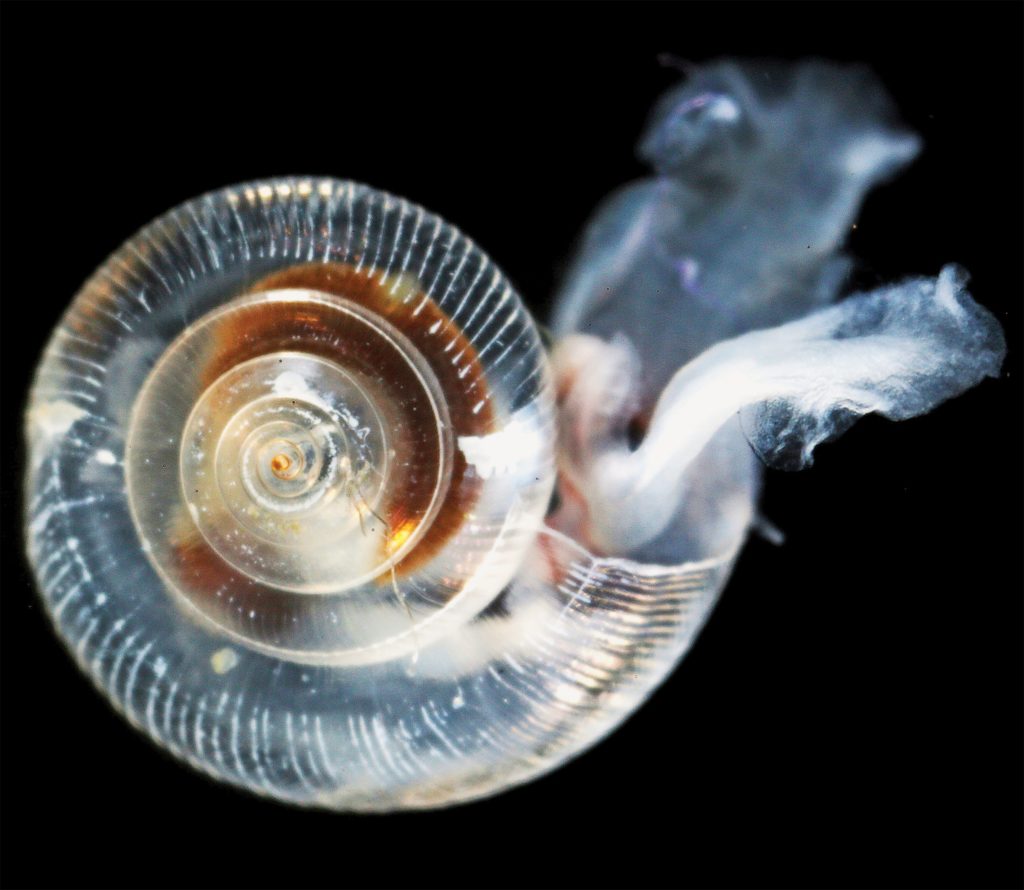
Researchers used 11 existing climate models to predict future ocean acidification based on a correlation they found between acidity and sea surface density (how dense seawater is changes with temperature and salinity).
The Arctic, in general, will bear the most severe effects of climate change, the study says. By the end of the century, surface temperatures in the region could increase by up to a range of 6.4 and 10.2 C and sea ice will continue to diminish.
A 2019 report from the Government of Canada found the country is warming at twice the rate of the rest of the world, while the Arctic is warming even faster. Canada’s own emission reporting indicates the country will not meet its climate commitment to reduce emissions to 30 per cent below 2005 levels by 2030 and keep the global temperature increase as close to 1.5 C as possible.
“It would be great if politicians listened more,” Terhaar said.
What ocean acidification means for Arctic marine wildlife
As the amount of carbon dioxide in the atmosphere increases, the planet warms and more of that carbon dioxide is dissolved in the surface of the ocean. The increase of dissolved carbon in the ocean decreases the ocean’s pH and also decreases the concentration of carbonate ion — a key component in the calcium carbonate used in the shells and skeletons of calcifying organisms.
These conditions produce water that will corrode shells, which a slew of marine organisms depend on to shore up their only line of defence against predators.
Oysters and pea-sized, swimming sea snails known as sea butterflies, for instance, can’t build their shells without calcium carbonate minerals, leaving them more susceptible to hungry marine mammals such as walruses and whales.
These creatures can adapt to aggressive changes to a degree, Terhaar said, but if acidification gets more pronounced, they simply won’t be able to keep up. He pointed to U.S. National Oceanic and Atmospheric Association laboratory tests that show the shell of the sea butterfly can almost completely disappear over a 45-day period when submerged in sea water with pH and carbonate levels projected for the year 2100.
Sea butterflies are as small as the pin of a head and are known to feed a wide variety of marine life from krill, to salmon to whales.
The study focused on the mesopelagic zone, or seawater at depths between 200 and 1,000 metres, because that range is important habitat for shell-building organisms and animals that live, feed or migrate there.
“All of these organisms may have a harder time surviving because the acidification is too strong there,” Terhaar said, adding that the concentration of carbonate ions will decrease by 50 per cent in this mesopelagic zone over the 21st century due to acidification. (Across all depths in the Arctic Ocean, that number will decrease by an average of 32 per cent over the same timeframe.)
The Arctic Ocean is relatively shallow, making these sources of food easy pickings. If overfeeding occurs, there could be nothing left for marine mammals to eat, Terhaar said.
“Even small changes in the future might really change the situation of these animals and organisms, and even if their shells are less strong than before, they will be much more vulnerable to predators, and step-by-step they will be gone from the food chain,” he said.
“I think it’s likely it’s going to be worse than before. It’s very hard to say what it’s doing to the food chain.”
An April 2020 State of the Arctic report produced by Fisheries and Oceans Canada acknowledges very little research has been done on the impacts of ocean acidification in the Arctic.
But the report notes that “the volume of corrosive water in the Arctic is increasing with time” and also affects “non-calcifying organisms.”
The negative impacts of ocean acidification on the physiological, reproductive and immune systems on these other organisms “have been reported in other oceans,” the report states.
Recent research by Andrea Niemi, a Fisheries and Oceans Canada scientist and lead author of the report, found that small pelagic sea snails collected in 2014 and 2017 had high levels of shell dissolution due to acidified waters (pictured below).

But the report concludes that “our knowledge of biological responses to ocean acidification in polar oceans is limited at present.”
Terhaar said more research on ocean acidification is also needed in the Southern Ocean around Antarctica, but that’s a wholly different environment, requiring a lot of preliminary work to study the ocean system there and how it might store carbon. “Personally, I just turned my attention to the Southern Ocean, maybe others are very close to publishing interesting research.”
“The Southern Ocean is totally open (water),” he said. “It has one of the strongest currents in the world.”
Studying the Antarctic would be critical to further understanding how carbon absorption and acidification is affecting global waters.
What needs to happen to alleviate the pressure of acidification on the oceans?
While this isn’t the first study to address ocean acidification in the Arctic, it serves as a reminder that people across the planet must work together to reduce greenhouse gas emissions, said Susanna Fuller, vice-president of operations and projects for Oceans North.
“Our oceans have been taking up an incredible amount of our carbon dioxide. They’ve just been absorbing, absorbing, absorbing,” she said. “The oceans have been mitigating this for us, but now they can’t absorb anymore without massively changing.”
She said while a lot of attention has been paid to increasing protection for terrestrial environments, the same doesn’t hold true for the oceans
Marine ecosystems, including seagrass meadows, kelp forests and marshes, are essential for sequestering what is known as “blue carbon.” According to the Blue Carbon Initiative, “seagrasses cover less than 0.2 per cent of ocean floor, but store about 10 per cent of the carbon buried in the oceans each year.” Yet, “seagrasses are being lost at a rate of 1.5 per cent per year and have lost approximately 30 per cent of historical global coverage.”
“Let’s make sure we’re preserving kelp forests and eelgrass beds and marine mammal populations and fish populations,” Fuller said, adding that this study shows ocean acidification is going from bad to worse. “We think about the terrestrial environment because we can see it. I don’t think Canada has really started to think how that can be done in the marine environment.”
Fuller said if the COVID-19 pandemic can be stemmed globally, so, too, can climate change impacts, including ocean acidification.
“We can do it.”
Update June 29, 2020 11:45 a.m. PST: This article was updated to correct references to the decrease in the concentration of carbonate ions over the 21st century. The article previously stated this concentration would decrease by 12 per cent in the mesopelagic zone and 6 per cent across all depths in the Arctic Ocean. However the correct amount is a 50 per cent decrease in the mesopelagic zone and a 32 per cent decrease across all depths. Additional comment was added from Jens Terhaar about his interest in furthering his research in the Southern Ocean around Antarctica where, he believes, other scientists may be doing additional research.
Paul Beckwith on simultaneous crop losses
Teaser: Global Food Supply at RISK from Simultaneous Crop Losses Due to Specific Jet Stream Patterns
Paul Beckwith
I have perfect timing starting this video. My face is illuminated by lightning and then seconds later you hear the thunder. Pop Quiz: How far away was the lightning bolt? A while ago, Michael Mann and others published a paper on how jet streams tend to get amplified and stuck in a persistent, quasi-resonance with wavenumbers 6 to 8 (Ridge-Trough wave pattern repeats 6 to 8 times around the Earth). I introduce you now to a new paper that finds modes 5 and 7 can cause simultaneous crop reductions in vital farming areas in North America, Europe, and Russia. This is obviously a huge threat to our global food supply
Subscribe to:
Comments (Atom)











Comment: The suggestion in the final paragraph above that the struggle for equal rights in the early 20th century is continuing today in the form of the recent BLM protests is, perhaps, an exaggeration. Today, black Americans have achieved equal rights under the law. There are no mobs of white people hunting down blacks. If anything, there is a significant risk that the BLM protests could devolve into black or BLM mobs hunting down white people.